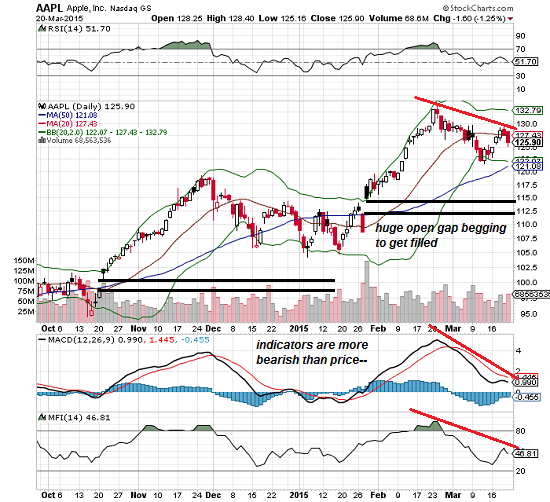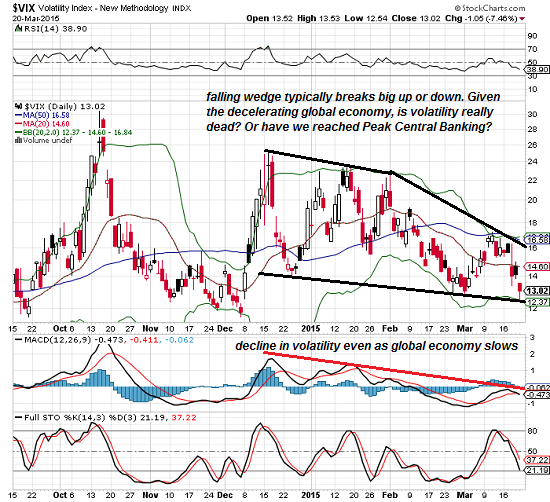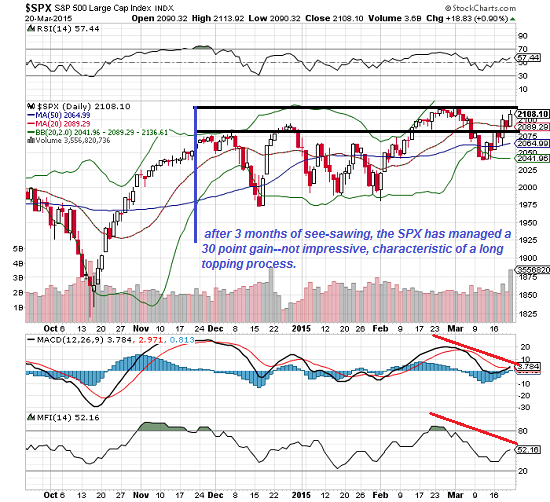Who Left the Crash Window Open?
March 23, 2015
Can stocks keep hitting new highs even as sales and profits fall?
Given that we live in a world where a modest 3% decline in the stock market triggers panicky demands for more quantitative easing (QE 4), few observers expect much a correction, regardless of the souring fundamentals such as sales and profits.
A correspondent notified me of a Puetz "crash" window (based on the analysis of Stephen J. Puetz) opening in late March-early April. (Since I am not a subscriber to Puetz's work, I can't confirm this.) As I understand it, while these windows do not predict a crash/sharp correction, such moves tend to occur in these windows, which are based on cycles and events such as eclipses.
So I decided to look for any evidence that a sharp correction might be in the offing.
One classic precursor of corrections is weakening market leaders and narrowing of breadth/liquidity/volume. When leaders who pulled the index higher roll over, the index is usually not far behind.
Consider the chart of Apple, (AAPL), long the engine that has been pulling the indices higher for years. Apple's chart is looking weak:

Another classic precursor of a decline is high levels of complacency, which is reflected in a low VIX or volatility index. When fear has been vanquished, the VIX declines to the 10-12 range. These levels reliably indicate market tops.
Interestingly, the VIX has been tracing out a descending wedge, a pattern that is usually bullish. (The VIX soars when stocks fall sharply and fear comes alive.)

The signs of a global slowdown are so plentiful that even the most ardent bulls should start feeling caution. Yet the central-bank-driven stock markets in the UK and Germany are hitting new highs, and the S&P 500 (SPX) in the US is within a few points of its all-time high.
But the S&P 500 is acting rather tired. Despite the declining VIX, the SPX has only managed a tepid 30-point gain in the past three months--months that are typically among the best in the calendar year for strong equity gains. This is characteristic not of a robust Bull trend but of a topping process--a process that typically takes several months to manifest.

Can stocks keep hitting new highs even as sales and profits fall? History suggests we've reached Peak Central Banking--the faith that central bank easing can push markets higher forever, regardless of fundamentals, has reached near-euphoric levels. Few fear a decline or an increase in volatility.
So it's all smooth sailing even as the global economy slides into recession? That is a disconnect from reality that beggars belief.
Perhaps the VIX will soon awaken from its slumbers, reflecting a "surprise" plummet in stocks.
NOTE: Contributions/subscriptions are acknowledged in the order received. Your name and email remain confidential and will not be given to any other individual, company or agency.
|
Thank you, Kaz M. ($10), for your much-appreciated generous contribution to this site-- I am greatly honored by your support and readership. |